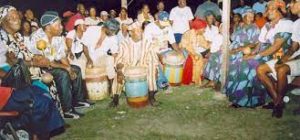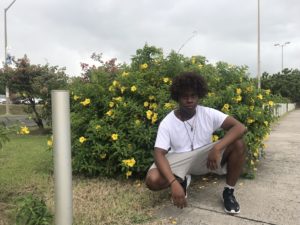|
Getting your Trinity Audio player ready...
|
Reading Time 3 mins
April 12, 2022
 In 2019, I had the pleasure of witnessing the Big Drum Dance firsthand. It was my first time in Carriacou, the land of my grandparents, and I was eager to see an African religious tradition for the very first time, one that I considered myself to be a part of being of Kayak1 descent. I was shocked, however, to find that many Kayaks I had spoken with, including my own family members, did not consider the Big Drum Dance (abbreviated BDD) to be a formal religion like Christianity. There was no name for those that took part in this practice unlike other ATRs/ADRs (African Traditional Religions/African Diasporic Religions). This spurred my passion to determine whether or not the BDD had enough validity to be considered a syncretic African religion, such as Lucumi, Palo Mayombe/Nkisi Malongo, Haitian Vodun, and others.
In 2019, I had the pleasure of witnessing the Big Drum Dance firsthand. It was my first time in Carriacou, the land of my grandparents, and I was eager to see an African religious tradition for the very first time, one that I considered myself to be a part of being of Kayak1 descent. I was shocked, however, to find that many Kayaks I had spoken with, including my own family members, did not consider the Big Drum Dance (abbreviated BDD) to be a formal religion like Christianity. There was no name for those that took part in this practice unlike other ATRs/ADRs (African Traditional Religions/African Diasporic Religions). This spurred my passion to determine whether or not the BDD had enough validity to be considered a syncretic African religion, such as Lucumi, Palo Mayombe/Nkisi Malongo, Haitian Vodun, and others.
Here at Big Drum Nation, many of us know of Carriacou’s Big Drum Dance, its legacy, and what it represents, but there are a few things to know that may shock you. For starters, the Big Drum Dance has been known by two other names, “The Nation Dance” and “Gwa Tambu”. It was even practiced in Grenada for a time until the presence of Yoruba slaves extinguished it with their own Ifa/Orisa faith, which is still present in Grenada and Trinidad in what is now known as Shango Baptism.
The BDD has allowed Kayaks to trace their ancestry to several African groups through the presence of nation songs within the tradition, but other songs therein imply connections to other African groups not explicitly mentioned. For example, certain songs, such as “Anansi-O Sari Baba”, and other Cromanti songs imply an Akan presence either on the island or an Akan influence on the enslaved Africans in Carriacou because Anansi is a distinct Akan deity, sharing no similarities with other spirits, unlike the Yoruba Orisha, Eshu-Ellegua and the Ewe loa/lwa, Legba. The mention of Vodun deities such as Legba, Mawu-Lisa, and Damballa, as well as Arada dances, imply connections to Ewe-Fon groups, either ancestrally or otherwise. The Qual Ring is yet another example, as it is documented by Winston Fleary to represent the Bakongo people and their spirits, known as Nkisi. These people managed to preserve their religion in Cuba, where it is commonly known as Palo Mayombe, but respectfully called Nkisi Malongo.
Despite these connections to ATRs/ADRs that are still practiced to this day, the Big Drum Dance has been chalked up as an “ancestral cult” by outsiders, placing it in a similar lane as Jamaica’s maroon religion, Kumina. This mixture between indigenous African practices and Christianity is known as syncretism2, and it was a tool utilized by enslaved Africans to preserve their traditions under the hostile environments of colonialism.
Carriacou’s minuscule size has made its traditional religion invisible to other Afro-Caribbean practitioners, whose religious numbers are swelling amidst the growing interest in these traditions. While many of the words sung in the Big Drum Dance are spoken in French creole, it does not utilize “vèvè’s” like the Haitian Vodun tradition. Songs are used to appease ancestral spirits and old gods of the numerous ethnic groups brought to the island, but there are no initiations into the tradition, as is the case with many other ATRs/ADRs (African Traditional Religions/African Diasporic Traditions).
All of this is not to say that the Big Drum Dance is merely a ceremonial tradition. I am of the belief that it is just as powerful and important as any other religion in the world, and that we, Kayak people, have a duty to not only preserve it but record it as much as we can so that it is not lost in our ever-shrinking world. Religion, like language and culture, is fluid. Perhaps the revival of this tradition in Grenada and Petit Martinique are the first steps in a long journey to rediscovering ourselves as indigenous, African people.
 Richard Perry Jr., also known as Raafeke, is a Guyanese-Grenadian creative writer focused on telling stories and preserving culture from the West Indies. The author of the novel Radiance Lost continues to study and spread the messages from our islands to the world abroad.
Richard Perry Jr., also known as Raafeke, is a Guyanese-Grenadian creative writer focused on telling stories and preserving culture from the West Indies. The author of the novel Radiance Lost continues to study and spread the messages from our islands to the world abroad.- Carriacou “Kayryouacou” is inherited from the Kalinago name for the island which means ‘island of reefs’. Carriacou natives are affectionately known as “Kayaks”. [↩]
- Syncretism is the formation of new religious ideas from multiple distinct sources, often contradictory sources. All religions (as well as philosophies, systems of ethics, cultural norms, etc.) possess some level of syncretism because ideas do not exist in a vacuum. People who believe in these religions will also be influenced by other familiar ideas, including their previous religion or another religion with which they are familiar. [↩]


Very important piece by this young-looking gentleman. I am so happy that we have young people that are investigating our past and appreciating our Amerindian, African, and East Indian retention. In this case our African retention. Too bad our pusillanimous leaders don’t take the time to enact policies to protect our great traditions. Even the people that are practitioner of the culture are often not fully aware of the great tradition they are upholding and the miracles it took to carry it on from generations to generations. This is evident by the following quote by Richard Perry Jr: “I was shocked, however, to find that many Kayaks I had spoken with, including my own family members, did not consider the Big Drum Dance (abbreviated BDD) to be a formal religion like Christianity.” This show, among other things, the importance of having our schools teach the youngsters about our traditions. Seems like we only appreciate our culture when White folks come to Grenada or the Grenadines and do their PHDs or write books on our culture like Lorna McDaniel etc (not to criticize her). I am arguing that our governments need to do more to educate our people and preserve our institutions. Big Drum is not just about drumming however – it involves the drummers, chac chac (maracas), a chantwell (lead singer), and dancers. The whole ensemble is accompanied by Nation Dancers. It is the most African of our Caribbean culture. Sometimes we think that rastafari is the standard bearer of African retention in the Caribbean. But the rastas were preceded by older traditions, such as Kuminah. Carriacou is a piece of Africa in the Caribbean and we need to preserve it.
Respect to young Perry and to the folks at Big Drum Nation editorial board for helping preserving our great tradition.
You write well and have deep insight, Mr Perry. Keep writing. Think of a book on the subject. Big Drum website is an excellent start (or continuum)!